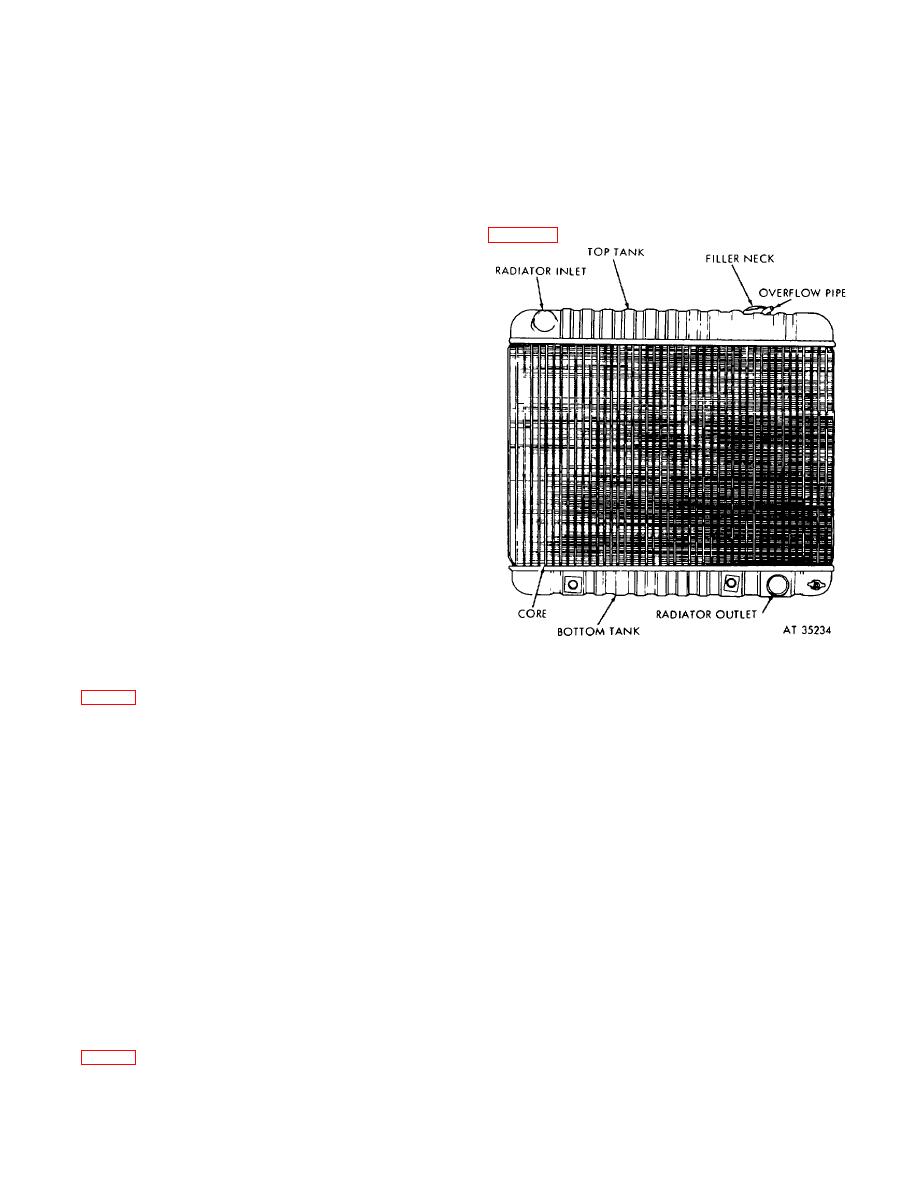 |
|||
|
|
|||
|
Page Title:
Steam Escape and Recirculation Tubes |
|
||
| ||||||||||
|
|
 b. Steam Escape and Recirculation Tubes. Some
a. General The usual radiator assembly consists of
overhead valve engines have a coolant tube connecting
a radiator core with a top tank and a bottom tank In some
the rear end of the cylinder head with top tank of the
designs, the tanks may be located on the sides of the
radiator, which allows escape of steam from the water
cores. The top, or inlet tank contains an outside pipe
jacket without causing overflow loss.
Coolant flows
called the radiator inlet and usually has a coolant baffle
through this tube into the radiator even with thermostat
inside and above, or at the inlet opening The radiator filler
valve closed, to prevent overcooling of the engine during
neck is generally attached to the upper part of the top tank
cold weather, the tube is equipped with a shut-off valve
and has an outlet to the overflow pipe The bottom tank
that can be closed. In another design, the tube from the
also has opening which is called the radiator outlet Refer
rear of the cylinder head is connected into the thermostat
to Chapter 3 for repair of radiator.
by-pass of that coolant flowing in the tube is recirculated in
the water jacket without entering radiator.
c. Core Hole Plugs In practically all engine water
jackets will be found a number of round openings which
are sealed by metal plugs driven into the holes. These
openings in the outside walls of the cylinder block or
cylinder head are necessary in the casting process, but
perform no cooling system function. The core hole plugs
which close these openings often incorrectly called "freeze
plugs" or "frost plugs". Although core hole plugs may be
forced out by a solid freeze-up In the water jacket, they are
not a safety device which can be depended on for the
prevention of freeze-cracking damage in the engine.
d. Other Fittings. In some engines a cover plate or
side plate is used to close a large opening on the side of
the cylinder block water jacket. One type of cover plate is
constructed with passages and outlet holes to provide for
distribution of coolant in a manner similar to that of the
water distribution tube. A few cooling systems have more
than one water outlet from the cylinder head and use an
assembly of metal piping called a "water manifold" to carry
the coolant to the radiator.
Figure 1-4. Radiator
1-8.
Fan and Shroud
b. Function of Tanks.
The top tank collects
incoming coolant and distributes it across the top of the
radiator core The baffle in the top tank assists in
a. Fan. Operation of the fan pulls a large volume of
distributing coolant to water tubes and also prevents
air through the radiator core Besides removing heat from
coolant from being thrown out of the radiator. The
the radiator, this flow of air also provides some direct air
overflow pipe provides an opening from the radiator for
cooling of the engine The fan provides most of the air flow
escape of coolant or steam that otherwise might cause
through the radiator at low road speeds when the forward
excessive pressure in the cooling system. The bottom
motion of the vehicle forces comparatively little air through
tank collects coolant flowing from the core and discharges
the core Reducing the size of the drive pulley increases
it through the radiator outlet.
the speed of the fan For operation in extremely hot
climates, larger fans and smaller pulleys are sometimes
c. Core Construction Practically all military cooling
installed.
systems have tubular radiator cores which consist of a
large number of vertical water tubes and many horizontal
b. Shroud. Military vehicles are generally equipped
air fins around the tubes. Water passages in the tubes are
with a tunnel-like structure around and behind the fan
usually very narrow, and the tube itself is made of very thin
called a shroud The purpose of the shroud is to direct the
metal
flow of air for most effective cooling. Some vehicles have
air baffles on the front side of the radiator to direct air flow
through the core.
1-9.
Radiator
1-4
|
|
Privacy Statement - Press Release - Copyright Information. - Contact Us |